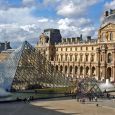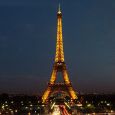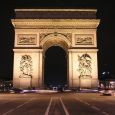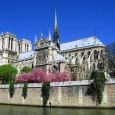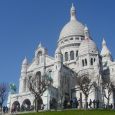Paris
Advertisement
By Air
Paris has two international airports: Paris Charles de Gaulle, also known as Roissy, and Paris Orly. Both offer flights to destinations across Europe as well as connections with North America, Africa, Asia and Australia. The city centre is easily accessible from both air hubs, with buses and taxis in plentiful supply, while Roissy also offers a TGV link; allow plenty of time for your journey to the airport ad traffic is renowned for being very congested on the lead up to both terminals.
By Rail
Paris has excellent rail connections to all major French centres as well as with many European capitals. The network of high-speed TGV trains complement the less speedy regular trains, while the Eurostar service runs from London to Paris several times a day. The primary stations are: Gare du Nord; Gare Montparnasse; Gare de l'Est; Gare de Lyon; Gare d'Austerlitz; and Gare Saint-Lazare. Visitors can connect with the Métro network at all of these stations.
By Bus
Paris has a comprehensive bus network, although many people choose not to travel to the city by this mode of transport, as journeys can be lengthy and uncomfortable, making rail travel preferable. Eurolines operates services to London, Amsterdam, Barcelona and Berlin among other cities. The main bus terminal is in the suburb of Bagnolet, which is a 30 minute Metro ride to the city.
By Car
Situated at the heart of the French road network, the capital is accessible from every point of the compass. Three orbital ring roads circle the city including the Périphérique; the A86 motorway and the A104, also known as the Francilienne motorway. From Brussels the city can be reached in 3 hours; Frankfurt in 6 hours; and Barcelona in 12 hours.
It is also possible for those coming from the UK to take their cars over on one of the ferry services from Dover to Calais and then drive to the capital. It is also possible for visitors coming from the UK to arrive in France via the Channel Tunnel, which links Folkestone and Calais via a rail service that can carry vehicles.
Advertisement
Eiffel Tower
Constructed of iron, this unique structure has grown to become one of Paris’ most loved monuments, despite significant opposition to the tower when it was first erected. Situated on the banks of the River Seine, the Eiffel Tower has now become a premier tourist hot spot and it was once the tallest structure in the world, while still ranking as the city’s tallest structure.
Designed by Gustave Eiffel, the tower is 300 metres (986 feet) high and provides excellent views across the city. It was built as the entrance for the 1889 World Fair as a temporary structure; however, the building was never torn down after, partly because it became useful as a communications transmitting tower. Those who are brave enough to travel up the tower will find two restaurants.
Louvre
The long and complex history of the Louvre extends over eight centuries of planning, building, destruction and reconstruction. Successive kings of France, from François I to Louis XIV, enlarged the medieval fortified castle into a sumptuous palace, until the establishment of absolutist rule led to the sudden transfer of the court to Versailles. The Louvre was then abandoned, half completed. Thereafter it provided homes and studios for such renowned painters as Fragonard and Chardin; Louis XVI returned briefly to his city palace; and finally in 1793 the Louvre became the prototype of the modern art museum.
The latest plan for the development of the Louvre, the "Grand Louvre" project, was launched in 1981 and is due to be completed by the end of the millennium. France's largest museum will then be the crowning feature in the government's program of grands projects for the closing years of the 20th century.
Arch de Triomphe
Located at the western end of Champs-Élysées, the triumphal arch stands at 51 metres (165 feet) tall. Its construction was instigated by Napoleon Bonaparte in 1806 to commemorate the victory at Austerlitz. The neoclassical arch incorporates works by many of France’s most prominent sculptor of the time, while the inner walls list the names of the generals who fell in the battle. The Tomb of the Unknown Soldier takes the central place beneath the arch, commemorating those who died in the World Wars.
Sainte-Chapelle
A palace chapel on two levels, the Sainte- Chapelle is the great jewel of Paris's Gothic architecture. It is only rarely, on very special occasions, used for worship, but is very frequently in use for concerts. To reach the chapel, turn left immediately inside the large iron gate at the main entrance to the Palais de Justice.
This marvel of High Gothic architecture was built for Louis IX in less than 33 months in 1245-48, probably by Pierre de Montreuil. The chapel was built to house the very precious Christian relics which Louis had acquired from the Byzantine Emperor - and which had cost him two and a half times as much as the building of the chapel. The chapel then stood in the main courtyard of the royal palace, the site of which is now occupied by the Palais de Justice. During the 18th century one side of the chapel was joined up with a wing of the Palais de Justice. For more than 30 years (1802-37) the chapel was used for the storage of records, before being restored between 1841 and 1867.
The chapel stands in the large inner courtyard to the left of the entrance to the Palais de Justice. It is 33m/110ft long by 17m/55ft wide, 76m/250ft high to the tip of the spire and 42m/140ft to the top of the gable.
Notre-Dame
The foundation-stone of the Cathedral of Notre- Dame de Paris was laid in 1163. Louis IX (St Louis) and Bishop Maurice de Sully, its founders, wanted to build on the Ile de la Cité a church which should resemble in style and beauty the first Gothic church which the Abbot of Saint-Denis had begun to build in 1135. The building of Notre-Dame extended over 150 years, during which all the various phases of Gothic architecture - partly taken over from the great cathedrals of Chartres, Reims and Amiens - were reflected in its structure.
The choir was built between 1163 and 1182, the nave between 1180 and 1200, both in Early Gothic style. The transition to High Gothic can be seen in the west front (1200-20) and the nave as altered between 1230 and 1250, pure High Gothic in the transepts (1250-60) and the choir as altered between 1265 and 1320.
Sacr Coeur
Built on Montmartre butte, the basilica is a popular spot for people to congregate at in the evenings to soak up buskers’ music and people watch while taking in the views across the city. Work on the Roman Catholic church began in 1884, after the architect, Paul Abadie, won a competition with his design. Constructed from travertine stone, giving the church its white appearance, the basilica has elements of both Romano and Byzantine styles.
Information not available
January - February -> 1(°C) - Winter
July - August -> 25(°C) - Summer
Advertisement

